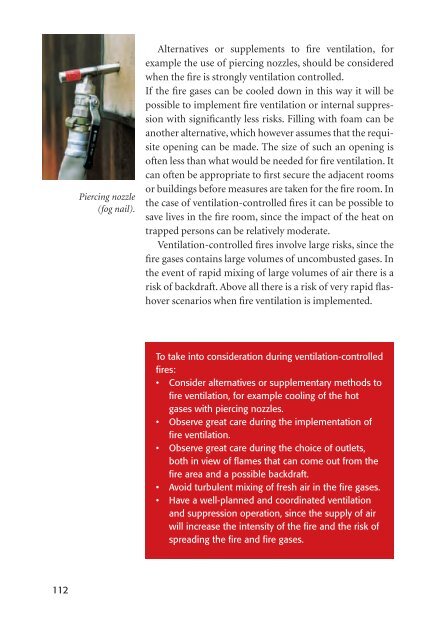Fire ventilation
Fire ventilation
Fire ventilation
Create successful ePaper yourself
Turn your PDF publications into a flip-book with our unique Google optimized e-Paper software.
112<br />
Piercing nozzle<br />
(fog nail).<br />
Alternatives or supplements to fi re <strong>ventilation</strong>, for<br />
example the use of piercing nozzles, should be considered<br />
when the fi re is strongly <strong>ventilation</strong> controlled.<br />
If the fi re gases can be cooled down in this way it will be<br />
possible to implement fi re <strong>ventilation</strong> or internal suppression<br />
with signifi cantly less risks. Filling with foam can be<br />
another alternative, which however assumes that the requisite<br />
opening can be made. The size of such an opening is<br />
often less than what would be needed for fi re <strong>ventilation</strong>. It<br />
can often be appropriate to fi rst secure the adjacent rooms<br />
or buildings before measures are taken for the fi re room. In<br />
the case of <strong>ventilation</strong>-controlled fi res it can be possible to<br />
save lives in the fi re room, since the impact of the heat on<br />
trapped persons can be relatively moderate.<br />
Ventilation-controlled fi res involve large risks, since the<br />
fi re gases contains large volumes of uncombusted gases. In<br />
the event of rapid mixing of large volumes of air there is a<br />
risk of backdraft. Above all there is a risk of very rapid fl ashover<br />
scenarios when fi re <strong>ventilation</strong> is implemented.<br />
To take into consideration during <strong>ventilation</strong>-controlled<br />
fi res:<br />
• Consider alternatives or supplementary methods to<br />
fi re <strong>ventilation</strong>, for example cooling of the hot<br />
gases with piercing nozzles.<br />
• Observe great care during the implementation of<br />
fi re <strong>ventilation</strong>.<br />
• Observe great care during the choice of outlets,<br />
both in view of fl ames that can come out from the<br />
fi re area and a possible backdraft.<br />
• Avoid turbulent mixing of fresh air in the fi re gases.<br />
• Have a well-planned and coordinated <strong>ventilation</strong><br />
and suppression operation, since the supply of air<br />
will increase the intensity of the fi re and the risk of<br />
spreading the fi re and fi re gases.

















